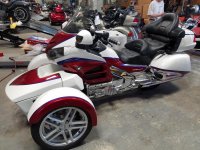It's
NOT an 'auto trans' like a car auto, it's a manual trans with a semi auto electric/hydraulic shift that's more precise than a manual shift, so
it isn't going to be robbing horsepower! Similarly, it's
NOT a torque converter, it's a hydraulic clutch that engages better than a centrifugal or most 'normal' automotive clutches can once there's oil pressure, so
it's not going to be robbing power either..... :sour:
However, with less than about 1000 miles on the engine, there
is a fairly good chance that it might still be a tad tight; but there's also a good chance that you are noticing the fairly aggressive hydraulic clutch engagement at slower speeds/revs (the oil pressure for the clutch comes from its own pump) giving you that clunky feeling; & the roll on & engine braking differences you notice are likely just a matter of cubic inches, or cubic centimetres if you like - 1800 is always going to be different to control than 1330 in a lot of ways.

Still, like I said earlier, it
is a fairly lazy engine, probably because of the way the computers doing all the controlling are set up; with any luck that could be 'livened up' a fair whack down track once the A/covering legal bods & bean counters become more confident about the ultimate safety of the design regardless of the skills (or lack there-of) of the riders just starting out on these things, they have been doing this slowly since the very first Spyders first hit the market. And of course, if you persist & give a go, once you learn better how to take advantage of the unique features of the design you'll get a whole lot quicker at cornering & punting it along smoothly & you'll be able to do that a fair bit faster than most start out doing too. It takes almost everyone
500-1000 miles or so to come to grips with the differences, often somewhat more for die-hard motor-cyclists who have more 'skills & expectations' to un-learn than most! :thumbup:

